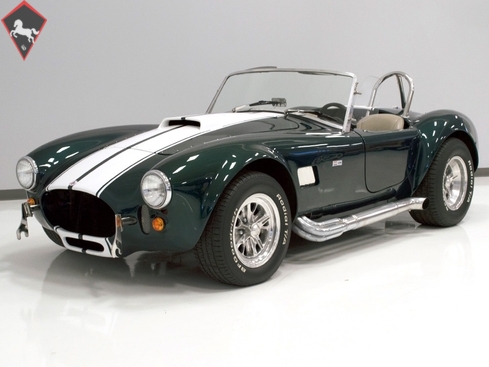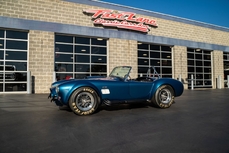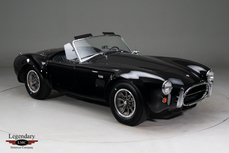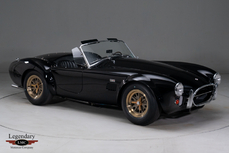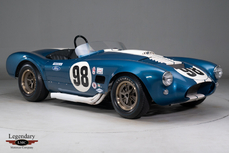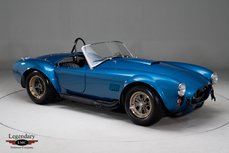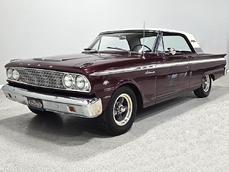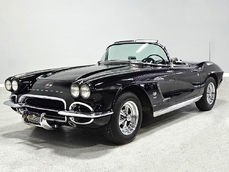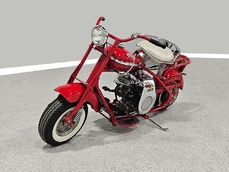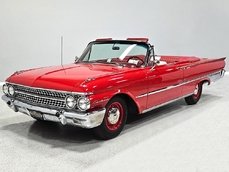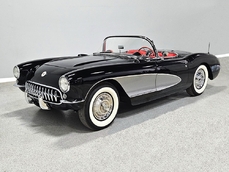Shelby Cobra 427 302 cubic inch V8 1965
Allgemeine Beschreibung :
Like everyone else selling a Cobra replica, I could start by telling you that the originals are seven-figure cars today and that this Shamrock Cobra replica is a more affordable way to own one. That’s true, of course, but it kind of misses the point. Cobra replicas have become a thing unto themselves, a vast industry with surprisingly high standards of performance and quality, churning out some delightfully functional sports cars that just happen look like original Cobras. Buying a replica like this Shamrock Cobra isn’t necessarily about trying to replicate the experience of the original, but rather celebrating minimalist horsepower, an open cockpit, and curvaceous bodywork, which were never more beautifully combined than in the Shelby Cobra. So no, I don’t think the experience of driving this car will make you feel like you spent a million dollars on it. What I know for certain, however, is that getting behind the wheel, lighting the fires, and hammering the throttle will make you grin so hard your face muscles will hurt when you get home. And THAT is why Cobra replicas are so awesome.
There seems to be a hierarchy of Cobra manufacturers, and Shamrock seems to enjoy a better reputation than most. It isn’t intended to be an exact replica, so you’ll see a stretch here and a tuck there, all intended to make their cars a bit more user-friendly. Professionally built and showing just 1204 miles on the clock, this is a great way to get into a Cobra right now, without the wait or expense of building your own. You can’t argue with the color combination, which is a lovely metallic Hunter Green with traditional Wimbledon White stripes, and a Cobra without stripes isn’t finished, I don’t care what you say. The heavy-duty fiberglass bodywork is nicely finished with good prep, flat surfaces, and panel gaps that are better than expected for a hand-built machine. The doors open and close easily, the trunk latches well, and you don’t have to slam the hood to get it close and it elevates itself on a pair of gas-charged struts. The paint is two-stage urethane that has a great shine, and while there are a few signs of use (most notably on the low-hanging chin), there’s nothing that needs attention. You’ll note it’s got race-style jacking stubs instead of bumpers, correct Lucas-style taillights, and a flip-up gas cap that should probably be standard equipment on every Cobra replica. The chrome windshield frame offers both wind wings and tinted Plexiglas sun visors and the exposed rivets on the hood are a link to the aluminum bodies that cost so many tens of thousands of dollars.
The tan leather interior (yes, it’s leather, not vinyl) is the ideal complement to the Hunter Green bodywork. It’s tasteful but functional, with wrap-around buckets that hold you in place without being constricting, and the low-back profile works perfectly in the low-slung Cobra bodywork. It’s finished for comfort as much as speed, so you get full door panels, black carpets, and a lot of rather nicely done French seams on the stitching. The dashboard is wrapped in more tan leather and uses familiar Smiths gauges, including the reverse-rotation speedometer that was a feature for many years. A set of warning lamps for high beams, alternator, and turn signals are in their own neat housing, while secondary controls for the wipers and headlights are on stalks on the steering column. The fat steering wheel feels racy and connects you directly to the front wheels, and the smaller diameter actually makes it a lot easier to slide behind the wheel than many replicas out there. The hides remain supple and comfortable and the carpets are unmarked, indicative of the low mileage, and everything works properly. Weather protection is, well, nil, but you do get a full cockpit tonneau as well as a frame for the top and a set of side curtains, so a top could probably be procured easily to make this car functional for longer trips in inclement weather. The trunk is also fully upholstered to hide the fuel cell and the battery has its own heavy-duty aluminum box.
The original Cobras used both small and big block engines, and if you ask the guys who actually used them as intended, most will tell you that a small block car is better balanced and almost as fast. A good majority of replicas run small block motors as well, for the very same reasons, and it’s probably why there’s a stout 302 cubic inch Ford V8 living under the hood today. Better known as the 5.0, it makes legendary torque and offers bulletproof reliability in its current under-stressed form. With a big Holley double-pumper carburetor and those wonderful side pipes, it has immediate throttle response and a big engine soundtrack to go along with it. The engine bay is quite neatly finished with plenty of chrome and polished aluminum, including the beautiful expansion tank for the cooling system. The radiator is tucked in at the nose of the car and uses a big electric fan to keep things cool and service access is awesome, although with this setup, you’ll spend far more time behind the wheel than under the hood. It starts easily with a bark from the side pipes and it idles well after a few seconds of warming up. There’s plenty of oil pressure, it doesn’t get fussy in traffic, and, well, this is how you always dreamed your Cobra would run.
The transmission is a Tremec T3550 5-speed manual feeding a Jaguar independent rear end with inboard disc brakes, twin coil-over shocks, and 3.73 gears inside, so acceleration is explosive at any speed. Shamrock used their own welded rectangular tube frame chassis which is heavily reinforced and braced, making a great platform for a lightweight performance car. The front suspension also appears to be from a Jaguar, including A-arms and big vented brake discs, which brings us to this Cobra’s most remarkable feature: the ride. For a lightweight 2-seat sports car with a giant V8 up front, you’d expect, even welcome, a tooth-rattling ride. This Cobra is different, offering crisp handling but a supple, comfortable ride that means you can enjoy it regularly without a second thought, and, perhaps more importantly, your significant other will never complain about how rough it is. The brakes are firm and confidence-inspiring, and it wears the right wheels: polished Halibrands with knock-offs wrapped in 235/60/15 front and 275/60/15 rear BFGoodrich T/A radials.
So please, don’t look at this as a cut-rate Cobra substitute, because that’s not giving it full credit. It’s a raw, elemental, 2-seat sports car with an all-American soundtrack, a huge wallop of torque on tap at any speed, and it’s far more comfortable than you’d ever expect. Come take it for a drive, we promise you’ll be surprised by just how sophisticated this car really feels.
http://www.harwoodmotors.com/vehicles/inventory_details.php?id=705
1965 Shelby Cobra 427 302 cubic inch V8 is listed verkauft on ClassicDigest in Macedonia by for $37900.
Fakten der Auto
Karosserietyp : Auto Marke : Shelby Modell : Cobra 427 Ausführung : 302 cubic inch V8 Hubraum : 0.0 Modelljahr : 1965 Lage : Ohio
Verkauft
Angaben Zum Verkäufer
Verkauft
People who viewed this Shelby Cobra 427 also viewed similar Shelby listed at ClassicDigest
Other cars listed for sale by this dealer
über Shelby
Carroll Shelby, eine legendäre Figur in der Automobilwelt, hatte einen bemerkenswerten Weg vom erfolgreichen Rennfahrer zum renommierten Sportwagenhersteller in den Vereinigten Staaten. Seine Geschichte ist voller Erfolge, Innovationen und ikonischer Autos, die einen unauslöschlichen Eindruck in der Branche hinterlassen haben.Frühe Jahre und Rennkarriere:
Carroll Shelby wurde 1923 in Texas geboren. Während des Zweiten Weltkriegs verfolgte er zunächst eine Karriere als Pilot, entdeckte aber nach dem Krieg seine wahre Leidenschaft im Rennsport. Shelby wurde in den 1950er Jahren ein erfolgreicher Rennfahrer und nahm an verschiedenen Veranstaltungen teil, darunter der Formel 1, Langstreckenrennen und den berühmten 24 Stunden von Le Mans.
Shelby Cobras – ikonische Sportwagen:
Carroll Shelbys entscheidender Moment als Hersteller kam mit der Entwicklung des Shelby Cobra, einem legendären amerikanischen Sportwagen. Die Cobra entstand aus der Fusion eines britischen AC-Ace-Chassis und eines Ford-V8-Motors und schuf ein leichtes Hochleistungsauto, das sowohl auf der Rennstrecke als auch auf der Straße dominierte. Zu den wichtigsten Modellen gehören:
Shelby Cobra 260 (1962): Die erste Version mit einem 260 Kubikzoll (4,2 l) V8-Motor.
Shelby Cobra 289 (1963–1965): Spätere Versionen mit einem 289-Kubikzoll-V8-Motor (4,7 l), einschließlich der Cobras mit Wettbewerbsspezifikation, die für ihre Rennfähigkeiten bekannt sind.
Shelby Cobra 427 (1965–1967): Die stärkste Version mit einem 427 Kubikzoll (7,0 l) V8-Motor, bekannt für seine rohe Kraft und Leistung.
Ford-Partnerschaft – Shelby Mustangs:
Shelbys Partnerschaft mit Ford führte zur Entwicklung der legendären Shelby Mustangs. Das bemerkenswerteste Modell ist:
Shelby GT350 (1965–1969): Basierend auf dem Ford Mustang wurde der GT350 von Shelby American modifiziert und zeichnete sich durch verbesserte Leistung, Handling und unverwechselbares Design aus.
Weitere bemerkenswerte Modelle und Erfolge:
Neben den Cobras und Mustangs leistete Shelby noch weitere bedeutende Beiträge:
Shelby Daytona Coupé: Dieses Auto wurde für den Sieg gegen Ferrari im internationalen GT-Rennsport entwickelt und war 1965 das erste amerikanische Auto, das die FIA GT-Weltmeisterschaft gewann.
Shelby Series 1: Ende der 1990er Jahre eingeführt, war dies Shelbys moderne Interpretation eines Hochleistungssportwagens.
Der Ford GT40 spielt in Carroll Shelbys Erzählung eine zentrale Rolle, insbesondere in Bezug auf seine Verbindung zu Ford und seinen bedeutenden Beitrag zum Erfolg des Autos.
Die Entwicklung des Ford GT40:
Fords Herausforderung:
Anfang der 1960er Jahre versuchte Henry Ford II, Ferrari zu erwerben, doch die Verhandlungen scheiterten. Dies bestärkte Ford in seiner Entschlossenheit, Ferrari beim prestigeträchtigen Langstreckenrennen 24 Stunden von Le Mans zu schlagen, das Ferrari mehrere Jahre lang dominiert hatte.
Zusammenarbeit mit Shelby:
Ford wandte sich an Carroll Shelby und schätzte dessen Rennsportkompetenz und Erfolgsbilanz. Shelby wurde damit beauftragt, das GT40-Projekt zu leiten und daraus einen konkurrenzfähigen Rennwagen zu machen, der Ferraris Vormachtstellung herausfordern konnte.
Entwicklung und Triumph:
Unter Shelbys Anleitung wurde der Ford GT40 einer gründlichen Entwicklung unterzogen, um anfängliche Designfehler und Leistungsprobleme zu beheben. Es wurden mehrere Iterationen erstellt:
Frühe Versuche: Die ersten Versionen des GT40 hatten Probleme mit der Zuverlässigkeit und dem Handling, was 1964 zu enttäuschenden Ergebnissen in Le Mans führte.
GT40 Mark II: Shelbys Team hat entscheidende Verbesserungen vorgenommen. Der Mark II, ausgestattet mit einem leistungsstarken V8-Motor, verbesserter Aerodynamik und verfeinerter Technik, wurde äußerst konkurrenzfähig.
Le-Mans-Sieg:
1966 errang der Ford GT40 Mark II einen historischen Sieg bei den 24 Stunden von Le Mans, wobei der von Shelby trainierte Fahrer Ken Miles das Rennen anführte. Dies war der erste Sieg eines amerikanischen Herstellers in Le Mans und brach damit die Dominanz von Ferrari.
Anhaltenden Erfolg:
Der GT40 dominierte weiterhin und gewann in den folgenden drei Jahren (1966–1969) Le Mans, sicherte sich seinen Platz in der Renngeschichte und festigte Fords Ruf als Kraft im internationalen Motorsport.
Shelbys Beitrag zum GT40-Erfolg:
Obwohl Carroll Shelby nicht direkt an der Entwicklung des GT40 beteiligt war, trugen seine Erfahrung im Rennsport und seine Fähigkeit, ein Team aus talentierten Ingenieuren, Mechanikern und Fahrern zusammenzustellen und zu leiten, entscheidend zur Verbesserung der Leistung des Autos bei. Sein Einfluss trug dazu bei, technische Probleme anzugehen, das Fahrverhalten des Autos zu verfeinern und Renntaktiken zu entwickeln, was maßgeblich zum Erfolg des GT40 auf der Rennstrecke beitrug.
Vermächtnis und Auswirkungen:
Die Siege des Ford GT40 in Le Mans unter Shelbys Führung gehören nach wie vor zu den ikonischsten Errungenschaften in der Geschichte des Motorsports. Der Erfolg des Autos festigte Shelbys Ruf als Automobilvisionär und stärkte seine Partnerschaft mit Ford weiter.
Carroll Shelbys Beteiligung am GT40-Projekt stellte seine Fähigkeit unter Beweis, ein schwieriges Projekt in eine Maschine zu verwandeln, die die Meisterschaft gewann, und fügte seiner illustren Karriere in der Automobilwelt ein weiteres bemerkenswertes Kapitel hinzu.
